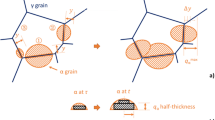Abstract
In this paper, the modeling of material phase transformation in grinding processes by examining strain rate and contact zone temperature to quantitatively link to the kinetics of diffusion-controlled as well as diffusionless transformations is presented. Based upon the addition of volume fractions in sequential segmented isothermal processes characteristic to grindings, physics-based modeling and prediction for the volume fraction of phase transformation in continuous heating under anisothermal conditions are developed. In validation of the predictive model, a series of maraging steel 250 grinding experiments, XRD measurements, and regression analyses were pursued. The comparison of experimental resulting data and the model prediction of volume fraction of austenite, martensite, and ferrite phases after grinding have been done. It is seen that the physics-based model presents the practicability to predict the incidence and extent of phase transformation as related to material properties, wheel characteristics, and grinding thermal–mechanical loadings.
Similar content being viewed by others
References
Zhu D, Li B, Ding H (2013) An improved grinding temperature model considering grain geometry and distribution. Int J Adv Manuf Technol 67(5–8):1393–1406
Foeckerer T, Zaeh MF, Zhang OB (2013) A three-dimensional analytical model to predict the thermo-metallurgical effects within the surface layer during grinding and grind-hardening. Int J Adv Manuf Technol 56(1–2):223–237
Li B, Ni J, Yang J, Liang SY (2014) Study on high-speed grinding mechanisms for quality and process efficiency. Int J Adv Manuf Technol 70(5–8):813–819
Ding Z, Li B, Zou P, Liang SY (2014) Material phase transformation during grinding. Adv Mater Res 1052:503–508
Shah SM, Nélias D, Zain-ul-abdein M, Coret M (2012) Numerical simulation of grinding induced phase transformation and residual stresses in AISI-52100 steel. Finite Elem Anal Des 11(6):1–11
Leblond JB, Devaux J (1989) Mathematical modelling of transformation plasticity in steels-I: case of ideal plastic phases. Int J Plast 5(6):551–572
Jakusa A, Fredenburg A, Thadhani N (2012) High-strain-rate behavior of maraging steel linear cellular alloys: mechanical deformations. Mater Sci Eng A 534:452–458
Guo Z, Sha W, Li D (2004) Quantification of phase transformation kinetics of 18 wt.% Ni C250 maraging steel. Mater Sci Eng A 373:10–20
Malkin S, Guo C (2007) Thermal analysis of grinding. Ann CIRP 2(56):760
Klocke F (2009) Process Design. Manufacturing Processes 2–Grinding, Honing, Lapping
Ni J, Li B (2012) Phase transformation in high-speed cylindrical grinding of SiC and its effects on residual stresses. Mater Lett 89:150–152
Han S, Melkote SN, Haluska MS, Watkins TR (2008) White layer formation due to phase transformation in orthogonal machining of AISI 1045 annealed steel. Mater Sci Eng A 488:195–204
Duscha M, Eser A, Klocke F, Broeckmann C, Wegner H, Bezold A (2011) Modeling and simulation of phase transformation during grinding. Adv Mater Res 223:743–753
Avrami M (1939) Kinetics of phase changes i: general theory. J Chem Phys 7:103–112
Avrami M (1940) Kinetics of phase changes ii: transformation-time relations for random distribution of nuclei. J Chem Phys 8:212–224
Olson GB, Cohen M (1975) Kinetics of strain-induced martensitic nucleation. Metall Trans 6A:791
Hedstrom P, Lindgren LE, Oden M (2007) Stress state and strain rate dependence of the strain-induced martensitic transformation in a metastable austenitic stainless steel. Proc 1st Int Symp Steel Sci, Iron Steel Inst Jpn
Mackenzie S (2008) Overview of the mechanisms of failure in heat treated steel components. ASM Int 44:43–86
Xiao G, Stevenson R, Hanna IM, Hucker SA (2002) Modeling of residual stress in grinding of nodular cast iron. J Manuf Sci Eng 124:833–839
Hou Y, Li C, Zhou Y (2010) Applications of high-efficiency abrasive process with CBN grinding wheel. Engineering 2:184–189
Li B, Ni J, Zhou Z, Yang J (2011) FEM simulation of strain rate in high speed grinding. Adv Mater Res 223:813–820
Childs THC (1998) Material property needs in modeling metal machining. Mach Sci Technol 2(2):303–316
Duan C, Kong W, Hao Q, Zhou F (2013) Modeling of white layer thickness in high speed machining of hardened steel based on phase transformation mechanism. Int J Adv Manuf Technol 69(1–4):59–70
Shi J, Liu CR (2006) On predicting chip morphology and phase transformation in hard machining. Int J Adv Manuf Technol 27(7–8):645–654
Koistinen DP, Marburger RE (1959) A general equation prescribing extent of austenite-martensite transformation in pure Fe-C alloys and plain carbon steels. Acta Metall 7:59–60
Jaeger JC (1942) Moving sources of heat and the temperature at sliding contacts. Proc Royal Soc NSW 76:203–224
Kim HJ, Kim NK, Kwak JS (2006) Heat flux distribution model by sequential algorithm of inverse heat transfer for determining workpiece temperature in creep feed grinding. Int J Mach Tools Manuf 46:2086–2093
Mamalis AG, Kundark J, Manolakos DE, Gyani K, Markopoulos A, Horvath M (2003) Effect of the workpiece material on the heat affected zones during grinding: a numerical simulation, international. Int J Adv Manuf Technol 22(11–12):761–767
Hacker RL (2002) Part surface roughness modeling and process optimal control of cylindrical grinding, Dissertation, Georgia Institute of Technology
Park HW, Liang SY (2009) Force modeling of microscale grinding process incorporating thermal effects. Int J Adv Manuf Technol 44(5–6):476–486
Jin T, Cai G (1999) Material strain rate enhancement and the size effect of grinding. Chinese Mech Eng 12(10):1401–1403
Kirkaldy JS, Thomson BA, Baganis EA (1978) Hardenability concepts with applications to steel. AIME, Warrendale, 82
Fonseca J, Marafona JD (2014) The effect of deionisation time on the electrical discharge machining performance. Int J Adv Manuf Technol 71(1–4):471–481
Kalajahi MH, Ahmadi SR, Oliaei SNB (2013) Experimental and finite element analysis of EDM process and investigation of material removal rate by response surface methodology. Int J Adv Manuf Technol 69(1–4):687–704
Fergani O, Liang SY (2013) Materials-affected manufacturing. Manuf Lett 1:74–77
Fergani O, Shao Y, Liang SY (2014) Temperature effect on grinding residual stress. Procedia CIRP 14:2–6
Author information
Authors and Affiliations
Corresponding author
Rights and permissions
About this article
Cite this article
Ding, Z., Li, B. & Liang, S.Y. Maraging steel phase transformation in high strain rate grinding. Int J Adv Manuf Technol 80, 711–718 (2015). https://doi.org/10.1007/s00170-015-7014-5
Received:
Accepted:
Published:
Issue Date:
DOI: https://doi.org/10.1007/s00170-015-7014-5




